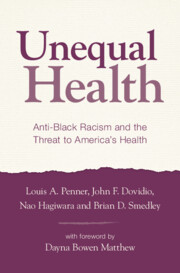Book contents
- Unequal Health
- Unequal Health
- Copyright page
- Dedication
- Endorsements
- Contents
- Figures
- Tables
- Foreword
- Prologue
- Acknowledgments
- Introduction
- Chapter 1 The Past Is Prologue
- Chapter 2 A Threat to the Common Good
- Chapter 3 “Two Americas”
- Chapter 4 Racism in American Medicine
- Chapter 5 Not Part of the Solution
- Chapter 6 A Dangerous Foot in the Door
- Chapter 7 Paths to a Solution
- Index
- References
Chapter 7 - Paths to a Solution
Ensuring a Basic Human Right
Published online by Cambridge University Press: 07 September 2023
- Unequal Health
- Unequal Health
- Copyright page
- Dedication
- Endorsements
- Contents
- Figures
- Tables
- Foreword
- Prologue
- Acknowledgments
- Introduction
- Chapter 1 The Past Is Prologue
- Chapter 2 A Threat to the Common Good
- Chapter 3 “Two Americas”
- Chapter 4 Racism in American Medicine
- Chapter 5 Not Part of the Solution
- Chapter 6 A Dangerous Foot in the Door
- Chapter 7 Paths to a Solution
- Index
- References
Summary
This chapter first summarizes eight threats to racial equity in health and healthcare identified in previous chapters. It then presents potential solutions to reduce their impact on Black Americans’ health. Two solutions involve lessening the impact of racial disparities in socioeconomic status on access to healthcare. The first involves broad-based efforts to improve the quality of education available to Black students, which should increase their future economic potential and thus ultimately improve their health. The second one is to establish comprehensive, single-payer insurance programs, making healthcare more available to everyone. Other proposed solutions address health threats caused by specific kinds of anti-Black racism. These solutions include programs to systematically reduce unfair and dangerous law enforcement practices and targeted investments in intentionally segregated communities to improve residents’ quality of life. A solution to the threat of inequitable healthcare is changing healthcare facilities’ focus from treating to preventing illnesses and dramatically increasing the number Black healthcare providers. Finally, a solution to the undue influence of patients’ race in healthcare outcomes is to develop interventions that reduce the impact of racial bias on healthcare professionals’ actions and equip Black Americans with the information and strategies that would make healthcare more accessible and supportive of them.
Keywords
- Type
- Chapter
- Information
- Unequal HealthAnti-Black Racism and the Threat to America's Health, pp. 297 - 346Publisher: Cambridge University PressPrint publication year: 2023

